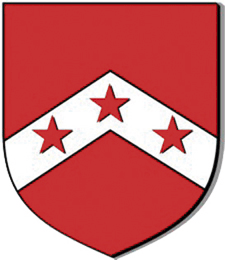The Kerrs of Ferniehirst
The first recorded Scotsman with the name of Kerr was John Ker of Stobo, Hunter of Swynhope on the de Bruys estates, listed in a Norman land survey made in 1190. In 1296 a Nicol Kerr of Peebles signed the ‘Ragman Roll’, a list of Scottish landowners accepting homage to Edward I of England. He would have to be a landholder to be on the roll, in common with the 4 other Kerrs listed.
The Kerr name appears in numerous documents as landholders in Roxburghshire including Altonburn, Crailing and the roots of the Ferniehirst branch at Kersheugh in Jedforest, the earliest surviving record being for a Ralph Kerr and his brother John, described as born at Kersheugh about 1270.
Throughout the next 170 years the family at Kersheugh display their growing importance in local and national politics through their marriages with Somervilles, Homes and Crichtons, all important families in the South of Scotland during the 13th and 14th centuries. A larger portion of the upper valley of Jedforest came into Kerr hands in 1457, as vassals of George Douglas, 4th Earl of Angus (1429-1463), these included the lands of Ferniehirst. The Kerrs were keepers of the royal hunting grounds of Jedforest and guardians of the border between England and Scotland.
It was during these years of the late 15th century that we note the first stone castle at Ferniehirst. Built by Sir Thomas Kerr of Smailholm (1448 - 1499) who married Margaret Kerr, the daughter, and only issue of Thomas Kerr of Kersheugh and Katherine Colville. Thomas of Smailholm was the son of Andrew Kerr of Cessford. In 1487 Thomas exchanged Smailholm with Home of Whitrig for Crailing and Hownam. Thomas Kerr and Margaret had 4 sons, Andrew, Ralph, Thomas and William.
When Sir Thomas died in 1499, it was his oldest son Andrew who became Laird of Ferniehirst, and it was Andrew, known as ‘Dand’ to his friends and enemies alike that would consolidate the growing power of the Kerrs and their influence as conflicts from Flodden to the ‘Rough Wooing’ of Henry VIII grew to a new intensity in the Borderlands, while the lawless reiving between families continued unabated with no allegiance offered except to the Patriach, and if the price was higher, then the Border mercenary would willingly fight in support of the English army.
clankerr.co.uk© 2011 • Privacy Policy • Terms of Use
These are the arms the Kerrs of Ferniehirst would have carried into battle and are made up of Gules, a chevron Argent with three mullets Gules. Gules describes the tincture of the colour red, argent is the tincture of silver, the chevron represents the roof of a house from the French word ‘chevron’ meaning rafter, it signifies protection and the chevron was granted to those families who had participated in some noble enterprise or had built churches or fortresses. A mullet is a representation of the rowel of a spur. These are English mullets, indicating the Norman origins of the Kerrs. The Scottish mullet includes a small circle inside the star.

